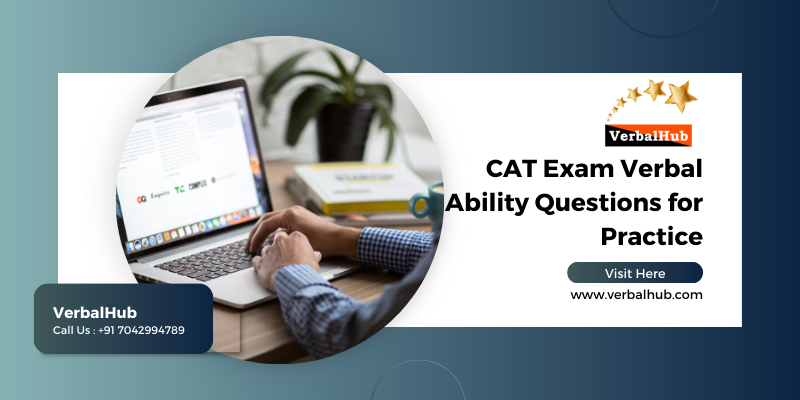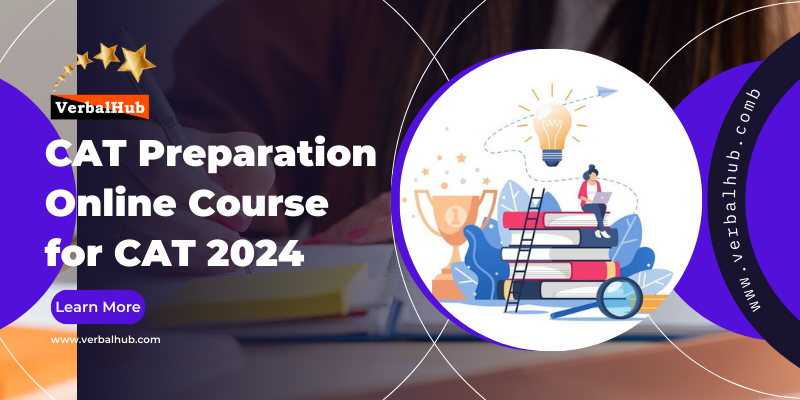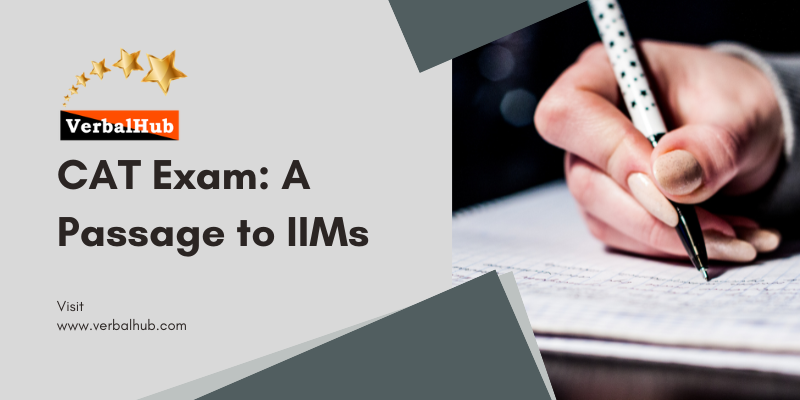

A Journey to CAT Syllabus or MBA Entrance Exam Syllabus
Before think of MBA, every candidates need to think of CAT syllabus or MBA entrance exam syllabus thus it is essential to know the CAT exam syllabus for MBA. The CAT syllabus includes three main sections: English known as VARC (verbal ability and reading comprehension), maths known as QA (Quantitative Aptitude), and reasoning known as LRDI (Logical Reasoning and Data Interpretation). Each section of MBA CAT syllabus is designed to test a candidate's proficiency and preparedness for the rigors of an MBA program. The CAT exam syllabus not only assesses quantitative and analytical skills but also evaluates verbal and reading comprehension abilities, which are crucial for effective communication and decision-making in the business world.
The CAT syllabus for 2024 is structured into three main sections: VARC, QA, and LRDI. Each section has its specific topics and weightage.1. Verbal Ability and Reading Comprehension (VARC)
| This section includes 24 questions: | VA 8 Questions + RC 16 Questions with four passage, each passage with 4 questions. |
| Reading Comprehension (RC): | Approximately 16 questions. Topics include passages on business, social sciences, economics, literature, science, and current affairs. Types of questions involve inference, main idea, author's view, and vocabulary. |
| Verbal Ability (VA): | Around 8 questions. Topics include para jumbles, para summary, sentence exclusion, and other types of questions like sentence completion or correction (iQuanta) (MBA Universe) (Top Colleges and Universities in India). |
2. Quantitative Aptitude (QA)
| This section has 22 questions covering: | |
| Arithmetic: | Time and work, ratio and proportion, profit and loss, and percentage. |
| Algebra: | Inequalities, quadratic equations, logarithms, and linear. |
| Geometry and Mensuration: | Topics include triangles, circles, and coordinate geometry. |
| Modern Math: | Includes sequences and series, set theory, probability. |
3. Data Interpretation and Logical Reasoning (DILR)
| This section contains 20 questions, divided into: | |
| Data Interpretation (DI): | Topics include data tables, bar diagrams, pie charts, graphs, and data analysis. |
| Logical Reasoning (LR): | Topics include seating arrangements, binary logic, blood relations, logical sequences, and assumption-premise-conclusion types of questions (iQuanta) (Top Colleges and Universities in India) (Ims India). |
Exam Pattern
| Total duration: | 120 Mintus (0 hours) | Each segment is allotted a duration of 40 minutes. The exam comprises 66 questions with a scoring pattern of +3 for correct answers, -1 for incorrect answers (only for MCQs), and no negative marking for non-MCQs. |
CAT Official Syllabus for VARC
The CAT official syllabus for 2024 is especially structured to evaluate a candidate's readiness for MBA programs that combines VARC, QA, and DILR. The CAT VARC syllabus focuses mainly two skills comprehension and reasoning skills however it also tests vocabulary and grammar. Understanding and mastering the CAT syllabus 2024 is crucial for aspirants aiming to secure a seat in top business schools.
The topics of Verbal Ability of the CAT syllabus 2024 are:| Para Jumbles: | |
| Correct Arrangement: | Rearranging sentences to form a coherent paragraph. |
| Example: | Put the sentences in correct sequence or logical order: |
| A. | She decided to stay back and help. |
| B. | The storm had caused significant damage. |
| C. | Volunteers were needed urgently. |
| D. | Many houses were destroyed. | Correct Order: B, D, C, A |
| Odd Sentence Out: | Identifying the sentence that disrupts the coherence of the given paragraph. |
| Example: | Identify the sentence that does not fit in the context of the following paragraph: |
| A. | The city has seen a significant increase in the number of green spaces. |
| B. | Parks and recreational areas are being developed to improve urban living. |
| C. | Many residents have started using bicycles for their daily commute. |
| D. | These green initiatives are part of a larger environmental conservation plan. | A., B., C., D., Answer: C. Sentence 3 |
Para Summary:
| Summarizing a given paragraph accurately. | |
| Example: | Summarize the following paragraph: | "Renewable energy sources such as solar and wind power are becoming more popular due to their environmental benefits. These energy sources are sustainable, reduce greenhouse gas emissions, and decrease our reliance on fossil fuels. Governments and corporations are ramping up their investments in renewable energy infrastructure." |
| Summary | Renewable energy sources are gaining popularity for their sustainability and environmental benefits, leading to increased investment by governments and businesses. |
Sentence Exclusion:
| Identifying and excluding the out-of-context sentence from a set of sentences. | |
| Example: | Identify the sentence that does not fit in the given paragraph: |
| A. | The economy is showing signs of recovery. |
| B. | The stock market has been performing well. |
| C. | Many investors are optimistic. |
| D. | The weather has been unusually warm. | Correct Answer: D |
Sentence Completion:
| Completing sentences with appropriate words or phrases. | |
| Example: | Complete the sentence: | "Despite the challenges, the team managed to __________." Correct Answer: "achieve its goals." |
Critical Reasoning:
| Questions based on assumptions, premises, and conclusions within a given text. | |
| Example: | Identify the assumption in the argument: | "Implementing renewable energy sources will reduce environmental pollution." |
| Correct Answer: | The argument assumes that renewable energy sources are less polluting than conventional energy sources. |
Analogies:
| Finding the relationship between pairs of words. | |
| Question: | Book : Read : Pen : ? |
| A. | Write |
| B. | Ink |
| C. | Paper |
| D. | Cap | Answer: A. Write |
Fill in the Blanks:
| Filling in blanks with the appropriate words based on the surrounding context. | |
| Example: | Fill in the blank with appropriate word: | "She was __________ by the complexity of the problem." Correct Answer: "perplexed" |
Vocabulary Based Questions:
| Synonyms and antonyms, word usage, and meanings of phrases. | |
| Example: | What does the word "ubiquitous" mean as used in the sentence: | "Smartphones have become ubiquitous in modern society." Correct Answer: "found everywhere" |
The section of Reading Comprehension of IIM CAT exam syllabus combines:
Reading Comprehension (RC):Not a direct part of Verbal Ability but often integrated into the section. It involves passages with questions on inference, main idea, author's view, vocabulary, etc.
These topics cover a wide range of verbal and reading comprehension skills, focusing on understanding and analyzing written material and applying grammar rules and vocabulary knowledge.
Main Idea Questions:
| The main idea questions ask you to identify the central theme or primary purpose of the passage. | |
| Example: | What is the primary purpose of the passage? |
Inference Questions:
| These questions require you to draw logical conclusions based on the information presented in the passage. | |
| Example: | Which of the following can be inferred from the passage? |
Title or Tone Questions:
| These questions ask you to determine an appropriate title or describe the author's tone or attitude. | |
| Example: | What would be the most appropriate title for the passage? |
Fact-based Questions:
| These questions focus on specific details or facts mentioned in the passage. | |
| Example: | According to the passage, which of the following is true about X? |
Vocabulary in Context:
| These questions ask you to determine the meaning of a word or phrase based on its context in the passage. | |
| Example: | What does the word "X" mean as used in the passage? |
Author’s View or Purpose Questions:
| These questions involve understanding the author's viewpoint or the purpose behind writing the passage. | |
| Example: | What is the author's viewpoint on X? |
True/False Statements:
| You need to identify whether a given statement is true or false based on the passage's information. | |
| Example: | According to the passage, is the statement "X" true or false? |
Phrase/Word Explanation:
| These questions ask for the explanation of specific phrases or words used in the passage. | |
| Example: | What does the phrase "X" mean in the context of the passage? |
Data-Driven Questions:
| These involve interpreting and analyzing any data presented within the passage, such as charts or tables. | |
| Example: | Based on the data presented in the passage, which of the following conclusions is valid? |
Supporting Ideas:
| These questions ask you to identify supporting ideas or evidence presented in the passage. | |
| Example: | Which of the following statements best supports the argument made by the author in the passage? |
CAT VARC Prep Strategy
IIM CAT exam syllabus needs sufficient time to cover especially CAT VARC syllabus. Understanding the CAT syllabus is crucial for effective preparation, as it covers a wide range of topics across Verbal Ability, Reading Comprehension, Data Interpretation, and Logical Reasoning. By focusing on each section of the CAT exam syllabus, candidates can develop targeted study plans to address their strengths and weaknesses, ultimately enhancing their performance in the highly competitive test.
Advanced CAT VARC Preparation Strategy
| 1. Reading Comprehension (RC): | |
| I. Daily Reading: | Read diverse materials daily, including newspapers (like The Hindu or The Indian Express), magazines (like The Economist), and online articles. |
| II. Speed Reading: | Practice improve comprehension speed. |
| III. Practice Passages: | Regularly practice passages from previous CAT papers and mock tests. |
| IV. Annotation: | Highlight key points, main ideas, and arguments in passages while reading. |
| V. Summarization: | Summarize each passage in a few lines to ensure you grasp the main idea. |
| 2. Verbal Ability (VA): | |
| I. Vocabulary Building: | Use apps like Magoosh or websites like Vocabulary.com to build a strong vocabulary. Read a wide range of literature to encounter new words in context. |
| II. Grammar and Usage: | Review grammar rules using resources like Wren and Martin’s grammar book. Practice grammar exercises to strengthen your understanding. |
| III. Para Jumbles and Summary: | Practice identifying the logical flow of sentences in para jumbles. Focus on summary questions by identifying the main ideas and avoiding details. |
| IV. Practice and Mock Tests: | Daily Practice: Solve a few VARC questions daily to maintain consistency. Timed Practice: Simulate the exam environment by practicing within set time limits. Mock Tests: Regularly complete full-length mock tests and thoroughly assess your performance. Error Analysis: Review your mistakes in mock tests to understand where you went wrong and how to avoid similar errors in the future. |
| 3. Strategic Approach: | |
| Sectional Timing: | Allocate time judiciously to each passage and question type. |
| Question Selection: | Identify and attempt simpler questions to quickly earn marks. |
| Guessing Strategy: | If unsure, eliminate clearly wrong options and make an educated guess. |
| 4. Regular Feedback and Improvement: | |
| Peer Review: | Have peers review your answers to gain new perspectives. |
| Mentorship: | Seek guidance from mentors or join coaching classes for expert advice. |
| Self-Assessment: | Continuously evaluate your progress and adapt your preparation strategy as needed. |
CAT VARC Prep Books
Preparing for the CAT VARC section requires a thorough understanding of the CAT VARC syllabus, which is an integral part of the MBA CAT syllabus. To excel in this section, candidates should refer to recommended CAT VARC books that provide comprehensive coverage of reading comprehension, verbal ability, and critical reasoning topics. As the CAT syllabus 2024 is detailed and extensive, a strategic approach, including the right study materials and regular practice, is essential for success. To prepare for VARC of the CAT exam 2024, the following books are highly recommended:
1. "How to Prepare for Verbal Ability and Reading Comprehension for the CAT" by Arun Sharma and Meenakshi Upadhyay.| Note: | This book is a staple for CAT aspirants focusing on VARC and offers the best guidance to all aspects of verbal ability and reading comprehension. |
| Key Highlights:: | Detailed coverage of all topics in VARC. Numerous practice questions with detailed explanations. Strategies for reading comprehension and verbal ability sections. Practice exercises and mock tests. |
2. "Verbal Ability and Reading Comprehension for the CAT" by Nishit K. Sinha
| Note: | Known for its structured approach, and all VARC topics essential CAT Exam 2024. |
| Key Highlights:: | Conceptual clarity and detailed explanations. Varied practice questions and exercises. Focus on improving reading comprehension skills. Tips and strategies for verbal ability questions. |
3. "Word Power Made Easy" by Norman Lewis
| Note: | Although not specifically for CAT, this book is excellent for building vocabulary, which is crucial for the VARC section. |
| Key Highlights:: | Comprehensive vocabulary building. Easy-to-follow exercises. Techniques to enhance word usage and understanding. |
4. "High School English Grammar and Composition" by Wren & Martin
| Note: | A classic resource for mastering English grammar for especially verbal ability. |
| Key Highlights:: | Detailed explanations of grammatical concepts. Numerous practice exercises. Useful for improving overall language skills. |
5. "The Pearson Guide to Verbal Ability and Logical Reasoning for the CAT" by Nishit K. Sinha
| Note: | This book provides a dual focus on verbal ability and logical reasoning, making it a comprehensive resource. |
| Key Highlights:: | Extensive coverage of verbal ability topics. Practice questions with detailed solutions. Logical reasoning practice to complement verbal skills. |
CAT Official Syllabus for Quant
The CAT Quant syllabus is a critical component of the CAT exam, encompassing a variety of mathematical concepts. The CAT Quantitative Aptitude syllabus covers areas such as arithmetic, geometry, number systems, and algebra. A thorough understanding of the quants syllabus for CAT is essential for aspirants, as it includes detailed topics like linear and quadratic equations, functions, and progressions within the CAT algebra syllabus. Here is a comprehensive list of topics in the Quantitative Aptitude (QA) section for the CAT 2024 exam, based on various sources:
1. Arithmetic| Percentages: | Calculations involving percentage increase or decrease. |
| Profit and Loss: | Problems on profit, loss, discount, and markup. |
| Simple and Compound Interest: | Calculations of interest over time. |
| Ratio and Proportion: | Solving problems based on ratios and proportions. |
| Time, Speed, and Distance: | Questions involving the relationship between time, speed, and distance. |
| Time and Work: | Problems on work done, efficiency, and time taken. |
| Averages: | Calculating averages of numbers. |
| Mixtures and Allegations: | Problems involving mixing of different entities. |
2. Algebra
| Linear Equations: | Solving single and systems of linear equations. |
| Quadratic Equations: | Solving quadratic equations and properties. |
| Logarithms: | Properties and calculations involving logarithms. |
| Inequalities: | Solving algebraic inequalities. |
| Functions: | Understanding types of functions and their properties. |
| Progressions: | Arithmetic and geometric progressions. |
3. Geometry and Mensuration
| Triangles: | Properties, theorems, and area calculations. |
| Circles: | Properties, theorems, and circumference/area calculations. |
| Polygons: | Properties and area calculations. |
| Coordinate Geometry: | Distance between points, section formula, and equations of lines. |
| Mensuration: | Surface area and volume of 2D and 3D shapes. |
4. Number System
| Divisibility Rules: | Rules and tests for divisibility of numbers. |
| Factors and Multiples: | Finding factors and multiples of numbers. |
| LCM and HCF: | Calculating the least common multiple and highest common factor. |
| Properties of Numbers: | Even, odd, prime numbers, and other properties. |
5. Modern Mathematics
| Permutation and Combination: | Counting principles and arrangements. |
| Probability: | Basic probability and its applications. |
| Set Theory | Concepts of sets, Venn diagrams, and operations on sets. |
| Binomial Theorem: | Expansion and properties. |
6. Miscellaneous Topics
| Surds and Indices: | Simplifying and calculating surds and indices. |
| Sequence and Series: | Problems on various types of sequences and series. |
| Exponents: | Rules and calculations involving exponents. |
| Matrices and Determinants: | Basic operations and properties. |
Quant Prep Strategy for CAT Quant Syllabus
A robust CAT prep strategy is essential for mastering the extensive CAT quant syllabus. The quant prep strategy should involve knowing the CAT quant syllabus for CAT, which covers all Quant topics. By focusing on these areas and practicing regularly, candidates can ensure they are well-prepared to tackle the quantitative section of the CAT exam effectively.
1. Advanced Problem-Solving Techniques:| Shortcuts and Tricks: | Learn and practice shortcut techniques for quicker calculations and problem-solving. |
| Advanced Materials: | Use advanced practice books and online resources to tackle higher difficulty questions. |
2. Regular and Varied Practice:
| Daily Practice: | Solve a variety of questions daily to cover all topics and maintain consistency. |
| Timed Sessions: | Practice with timer and improve speed and accuracy. |
| Mock Tests: | Attempt CAT full-length with timer and manage time effectively. |
3. Error Analysis and Improvement:
| Review Mistakes: | Analyze errors in practice problems to know weak areas. |
| Target Weak Areas: | Focus extra practice on weaker areas to build confidence and improve performance. |
4. Strategic Question Selection:
| Easy First: | Start with easier questions to secure marks quickly and build momentum. |
| Moderate Next: | Move on to moderate-level questions once easier ones are done. |
| Difficult Last: | Attempt difficult questions only if time permits, ensuring you maximize overall score potential. |
5. Regular Revision:
| Conceptual Revision: | Regularly revise important topics, concepts, rules, and formulas. |
| Practice Papers: | Solve old CAT questions and frequently asked question types. |
CAT Quant Prep Books
To prepare the CAT quantitative aptitude syllabus and to master the CAT quant syllabus, candidates should refer to renowned CAT quant books that provide comprehensive coverage and advanced problem-solving techniques. Understanding the detailed CAT syllabus 2024 is crucial, as it helps in focusing on key topics like arithmetic, algebra, and geometry, ensuring a well-rounded preparation for the quantitative section. For preparing for the Quantitative Aptitude (QA) section of the CAT exam, selecting the right book is crucial for effective study. Few good books are:
1. "How to Prepare for Quantitative Aptitude for the CAT" by Arun Sharma
| Note: | This book is one of the most recommended resources for CAT aspirants. It covers all the essential topics in Quantitative Aptitude, providing a structured approach to problem-solving. |
| Key Highlights: | Comprehensive coverage of all topics. Various levels of difficulty to help students at different preparation stages. Numerous practice questions with detailed solutions. Tips and strategies for improving speed and accuracy. |
2. "Quantitative Aptitude Quantum CAT" by Sarvesh K. Verma
| Note: | This book is known for its in-depth coverage and variety of questions, making it a favorite among serious CAT aspirants. |
| Key Highlights: | Detailed explanation of concepts. A good number of question and all level of difficulties. Conceptual clarity with numerous solved examples. Practice exercises and mock tests. |
3. "Quantitative Aptitude for Competitive Examinations" by R.S. Aggarwal
| Note: | While not exclusively for CAT, this book is comprehensive and covers a wide range of topics in Quantitative Aptitude. It's particularly useful for building a strong foundation. |
| Key Highlights: | Extensive question bank covering various topics. Step-by-step solutions to problems. Suitable for basic to intermediate level preparation. Good for practice and building conceptual understanding. |
4. "The Pearson Guide to Quantitative Aptitude for CAT" by Nishit K. Sinha
| Note: | This book is well-structured and covers all the essential topics required for the CAT exam. It includes numerous examples and practice questions. |
| Key Highlights: | Clear explanation of concepts. Numerous practice exercises. Tips and strategies for solving complex problems. Mock tests for self-assessment. |
5. "Quantitative Aptitude for CAT" by Trishna Knowledge Systems
| Note: | Published by Pearson, this book is designed specifically for CAT aspirants and provides a detailed approach to Quantitative Aptitude. |
| Key Highlights: | Comprehensive coverage of QA topics. Detailed solutions and explanations. Practice questions of varying difficulty levels. Conceptual clarity and practical approach. |
CAT DILR Syllabus for CAT 2024
The CAT exam demands a thorough understanding of its diverse sections, including the CAT DILR syllabus, which is a crucial part of the overall CAT syllabus. The IIM CAT exam syllabus covers various topics in Data Interpretation and Logical Reasoning (DILR), requiring candidates to develop strong analytical and problem-solving skills. Mastering the CAT syllabus involves focusing on specific areas such as puzzles, data sufficiency, and logical connections, which are essential for success in the DILR section. Here is a list of Data Interpretation (DI) topics for the CAT exam 2024, along with examples for each topic:
| 1. Tables | ||||
| Example: | What is the percentage increase in sales of Product A from Q1 to Q4? | A table shows the sales data of four different products (A, B, C, D) over four quarters of a year. | ||
| Product | Q1 | Q2 | Q3 | Q4 |
| A | 50 | 60 | 70 | 80 |
| B | 40 | 50 | 60 | 70 |
| C | 30 | 40 | 50 | 60 |
| D | 20 | 30 | 40 | 50 |
| 2. Bar Charts A bar chart shows the production of three different companies (X, Y, Z) over three years. |
|
| Example: | In which year did Company Y produce the highest amount? |
| 3. Pie Charts A pie chart represents data of companies in a specific industry. |
|
| Example: | If the total market size is 200 units, how many units does Company B hold if its market share is 25%? |
| 4. Line Graphs A line graph depicts the monthly revenue of a company over six months. |
|
| Example: | During which month did the company experience the highest growth in revenue? |
| 5. Venn Diagrams A Venn diagram shows data in different numbers. |
|
| Example: | How many students follow certain details? |
| 6. Caselets A caselet provides a scenario about a company's logistics and includes various data points such as shipment times, costs, and quantities. |
|
| Example: | Based on the provided data, calculate the average shipment time for the month of January. |
| 7. Data Sufficiency You are presented with two statements and need to assess if they offer sufficient information to resolve the question. |
|
| Example: | Is the number X greater than 10? |
| Statement 1: | X is greater than 5. |
| Statement 2: | X is less than 20. |
| 8. Combination of Charts and Graphs A problem set includes a combination of a bar chart and a pie chart to represent different aspects of sales data. |
|
| Example: | Using the bar chart and pie chart, determine the total sales of Product Z in Q3. |
| 9. Scatter Plots A scatter plot illustrates the correlation between advertising expenditure and sales revenue. |
|
| Example: | What type of correlation exists between advertising spend and sales revenue? |
| 10. Histograms A histogram shows the frequency distribution of test scores in a class. |
|
| Example: | How many students scored between 70 and 80? |
CAT Reasoning Syllabus for CAT 2024
Preparing for the CAT exam involves a deep dive into the CAT official syllabus, with particular focus on the CAT DILR syllabus. The CAT reasoning syllabus is a vital part of this, encompassing topics like logical puzzles, data interpretation, and analytical reasoning. Mastering these areas within the CAT DILR syllabus is essential for candidates aiming to excel in the logical reasoning and data interpretation sections of the exam.
Here are the key topics of the Logical Reasoning (LR) section for the CAT exam 2024, along with examples for each topic:
| 1. Seating Arrangements Eight individuals (A, B, C, D, E, F, G, and H) are arranged in a straight line facing north. B sits immediately to the right of A, with C positioned fourth to A's right. E is located between D and F, while G sits directly to the right of F. |
|
| Example: | |
| Question: | Who is seated at the far left end of the row? |
| 2. Blood Relations A is B's brother. C is B's daughter. D is C's sister. E is A's father. |
|
| Example: | How is D related to E? |
| 3. Syllogisms | ||
|---|---|---|
| Statements All dogs are animals. Some animals are cats. |
||
| Example: Which of the following conclusions can be logically drawn? | ||
| (i) Some dogs are cats. (ii) All cats are dogs. (iii) Some animals are dogs. |
||
| 4. Puzzles There are five houses in a row painted in different colors. The house in the middle is green. The house to the left of the green house is blue, and the house to the right of the green house is red. The yellow house is positioned to the left of the blue house. |
|
| Example: | What is the order of the houses from left to right? |
| 5. Arrangements Six individuals (P, Q, R, S, T, U) are seated around a circular table facing the center. Q sits second to the left of T. S is immediately to the right of U. R is positioned third to the left of P. |
|
| Example: | Who is seated between T and U? |
| 6. Clocks and Calendars If today is Monday, which day of the week will it be 50 days from now? |
| 7. Binary Logic | |
| Question: | Who is telling the truth? |
| Example: | Three persons (A, B, C) make the following statements: | A says, "B is telling the truth." B says, "C is lying." C says, "A is lying." |
| 8. Coding-Decoding | |
| Example: | In a certain code language, "MANGO" is written as "NCOPH." How is "APPLE" written in that code? |
| 9. Series Completion | |
| Example: | Find the next term in the series: 2, 6, 12, 20, ... |
| 10. Direction Sense What is his distance and direction from the starting point? |
|
| Example: | A person walks 5 km north, then turns right and walks 3 km. He then makes another right turn and walks 5 km. Finally, he turns left and walks 2 km. |
| 11. Matrix Arrangements | |
| Example: | On which floor does D live? | Arrange the given information in a matrix form: Five people (A, B, C, D, E) live on different floors of a building. A lives on the second floor. B lives on the floor above A. C lives two floors above B. |
| 12. Logical Sequences | |
| Example: | Identify the next figure in the sequence of shapes: | Square, Triangle, Circle, Square, Triangle, ... |
Advanced CAT DILR Preparation Strategy
Effective CAT DILR prep is essential for acing the exam, given the comprehensive nature of the CAT DILR syllabus. This section, which forms a significant part of the IIM CAT exam syllabus, requires a solid understanding of data interpretation and logical reasoning. The CAT reasoning syllabus covers various challenging topics, including puzzles, seating arrangements, and data analysis. To excel in this section, candidates must focus on mastering these areas, practicing regularly, and applying advanced problem-solving techniques to enhance their overall performance.
| 1. Strengthen Fundamentals: | ||
|---|---|---|
| Conceptual Clarity: | Ensure you understand the basic concepts and types of questions that appear in the DILR section. | |
| Standard Materials: | Use books like "How to Prepare for Data Interpretation & Logical Reasoning for CAT" by Arun Sharma. | |
| 2. Advanced Problem-Solving Techniques: | ||
|---|---|---|
| Speed and Accuracy: | Practice speed calculation techniques and improve accuracy in interpreting data. | |
| Logical Deduction: | Enhance logical deduction skills by regularly solving complex puzzles and reasoning problems. | |
| 3. Regular and Varied Practice: | ||
|---|---|---|
| Daily Practice: | Solve a mix of DI and LR questions daily to maintain consistency and cover all types of problems. | |
| Timed Sessions: | Practice within timed conditions to improve skills of time management. | |
| Mock Tests: | Regularly take full-length mock tests and sectional tests to gauge your preparation and adjust strategies accordingly. | |
| 4. Error Analysis and Improvement: | ||
|---|---|---|
| Review Mistakes: | Analyze errors in practice problems and mock tests to understand where you went wrong and how to avoid similar mistakes in the future. | |
| Targeted Practice: | Focus extra practice on weaker areas to build confidence and improve performance. | |
| 5. Strategic Question Selection: | ||
|---|---|---|
| Easy First: | Start with easier sets to secure marks quickly and build momentum. | |
| Moderate Next: | Move on to moderate-level sets after completing easier ones. | |
| Difficult Last: | Attempt difficult sets only if time permits, ensuring you maximize your overall score potential. | |
| 6. Regular Revision: | ||
|---|---|---|
| Conceptual Revision: | Regularly revise key concepts and techniques to keep them fresh in your mind. | |
| Practice Papers: | Solve 2023, 2022, 2021, 2020, and etc. to get the experience of test attempt. | |
CAT DILR Prep Books
Preparing for the CAT exam requires a strategic approach, especially when tackling the DILR section. Utilizing the best CAT DILR prep books is crucial for mastering the comprehensive CAT DILR syllabus. Accessing the CAT syllabus PDF and the CAT exam syllabus PDF can provide a clear understanding of all the topics covered. For a complete overview, the MBA CAT syllabus PDF is an invaluable resource, helping candidates plan their study schedule effectively and focus on key areas for success in the exam. Some recommended DILR books are:
1. "How to Prepare for Data Interpretation & Logical Reasoning for CAT" by Arun Sharma
| Note: | This book is highly recommended for its comprehensive coverage of both Data Interpretation and Logical Reasoning. It provides numerous practice questions and detailed solutions, making it easier to understand various concepts and strategies. |
| Key Highlights: | Various levels of difficulty to cater to all preparation stages. Section-wise segregation to focus on specific areas. Practice exercises with detailed explanations. |
2. "Logical Reasoning and Data Interpretation for the CAT" by Nishit K. Sinha
| Note: | Another excellent resource that offers a good mix of theory and practice questions. This book is designed to help students build a strong foundation in DI and Logical Reasoning. |
| Key Highlights: | Conceptual clarity with a focus on fundamental techniques. A diverse range of questions, spanning from fundamental to advanced levels. Strategies and tips to solve complex DI problems efficiently. |
3. "Data Interpretation for the CAT" by Gautam Puri
| Note: | This book focuses specifically on Data Interpretation and includes a wide range of questions that help students practice different types of DI sets commonly seen in the CAT exam. |
| Key Highlights: | Extensive practice questions and mock tests. Detailed solutions to help understand the problem-solving approach. Emphasis on improving speed and accuracy. |
4. "CAT Data Interpretation & Logical Reasoning" by Gajendra Kumar
| Note: | This book offers a structured approach to DI and Logical Reasoning with a focus on solving a variety of problems. |
| Key Highlights: | Step-by-step approach to solving DI questions. Multiple practice sets with varying difficulty levels. Tips and techniques to improve problem-solving speed. |
5. "A Modern Approach to Logical Reasoning" by R.S. Aggarwal
| Note: | Although it covers both Logical Reasoning and Data Interpretation, this book is known for its wide range of practice questions and clear explanations. |
| Key Highlights: | Extensive question bank for thorough practice. Detailed explanations and solving strategies. |
At the end, Good for building a solid foundation in DI and Logical Reasoning. If you're preparing for the CAT exam, you need updated study materials according to CAT syllabus. Downloading a CAT syllabus PDF can provide an overview of CAT exam. For those specifically focusing on an MBA, the MBA CAT syllabus PDF is an invaluable resource, outlining the necessary subjects in detail. By reviewing the CAT exam syllabus PDF, you can ensure that you're well-prepared for each section of the test. Additionally, the MBA CAT syllabus PDF helps to plan your CAT prep.
Our Teachers

Dr. G Ravindra Babu
Quant Faculty
Ph. D in Mathematics Asian International University|| Mathematics Professor at Gitam University || Ex-Mathematics Professor SRM University Amaravathi || MBA in finance Acharya Bangalore B School || GMAT Quant 51, CAT Quant 99.58 %tile, GRE Quant 170 || 21 Different Teaching Certification || Believe in “Education is the mother of leadership”
view details

Dr. Rengarajan Parthasarathy
CAT Faculty
Ph. D in Mathematics from YCM University|| Mathematics Professor at Symbiosis International|| Author of Business Ethics || Ex-CAT Exam Syllabus Advisor in IIM || MBA & MPM from Symbiosis International (Deemed University) || College Topper in Mathematics in Ferguson College || Six Scholarships in Mathematics || 15 Years CAT Coaching, GMAT Coaching and GRE Coaching Experience|| UGC NET Qualified || GMAT Q51, V38 & CAT Q 99.31 & DILR 99.38 %tile, GRE Quant 170 || Believe in “Higher Education Shapes The World.”
view details

Dr. Nisha Tejpal
Verbal & AWA Faculty
Ph. D in English || Published a paper in English in ‘Research Journal of Philosophy and Social Sciences’ || MCA and B.Ed CCS University || A subject expert in Verbal Teaching || 10,000 Plus Essays Analysis || CTET and NET Qualified || More than 15 years of Experience || A writer, Author and Poet || Believe in “Think Beyond the Universe”
view details

Dhrithi Khattar
Verbal Faculty
A subject expert in Verbal Aptitude || More than 15 years of Experience || MBA in HR& Marketing & MA in Economics || Active Member of Hindu Alumni Association || Functional Member of Delhi ||Management Association (DMA) || Operational Member of All India Management Association (AIMA) ||The President of Key Club ||An active member of the French Club ||Gold Seal from California Scholarship Federation.
view details
M. U. Mir
DILR & Quant Faculty
A subject expert in Quantitative Aptitude Training || GMAT Q 51 & CAT DILR 99.75 %tile || GATE 2020 Qualified || M. Tech & B. Tech University Toper (1st Rank) || Awarded by Gov of Odisha, Bihar and J& K for the project Magnetic Floating Model || Ex-Quant Subject Expert in Arihant Publication || An Educationist and Social Worker || Believe in “Education is power”
view details

C. S. Rajawat
CAT Faculty
M. A in Mathematics CCS University|| M. Tech from SRM University || Visiting Mathematics Faculty CCS University ||Experience of 11 Years of CAT Coaching || District Topper in 10th & 12th || Best Teacher Awardee in 2021 & 2022 || CAT Quant 99.43 %tile || Discovered a new Theorem based on HCF in Math || Founder of C. S. Classes ||Believe in “Teaching and Training is an Art.”
view details

Dr. S.K. Singh
PTE/IELTS/CELPIP Expert
Ph. D. English Dr. B. R. Ambedkar University || Delhi & Center Government School Mentor || Founder of Entrepreneur & Learning Startup || IELTS & CELTA Certified from British Council || PTE Certified from Pearson...
view details
Rishabh Arora
PTE/IELTS/CELPIP Expert
MBA in HR International Institute of Management Sciences || PTE Certified from Pearson Test of English|| IELTS & CELTA Certified from British Council || BCA from Integral University || PTE 87 in 2017, IELTS 8.5 in 2018
view details
Jyoti Joshi
IELTS Trainer
Master in English (MA) and Bachelor in Education (B.Ed) || Certified Trainer || IELTS Speaking 9.0 Band holder || Believe in “Great teacher can inspire hope, ignite the imagination, and instill a love of learning”
view details
Surbhi Arora
IELTS / PTE Expert
English Language Expert || More than 3 years of Experience || M.A plus B. Ed Delhi University ||Author, Writer & Classical Singer|| Believe in “Language Language Learning & Teaching is Fun”
view details

Dilip Kumar Rathore
Quant Trainer
A business developer and genius in mathematics || Highly experienced || Master in Maths || well-verse in IT || Believe in “The art of teaching is the art of assisting discover”
view details

Imaam Hasan
Communication Expert
Master in English || Journalist and writer || Certified IELTS & PTE Trainer || A social educater and influencer || Believe in “Education is the movement from darkness to light”
view details










